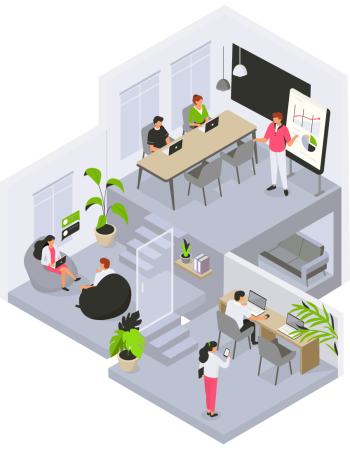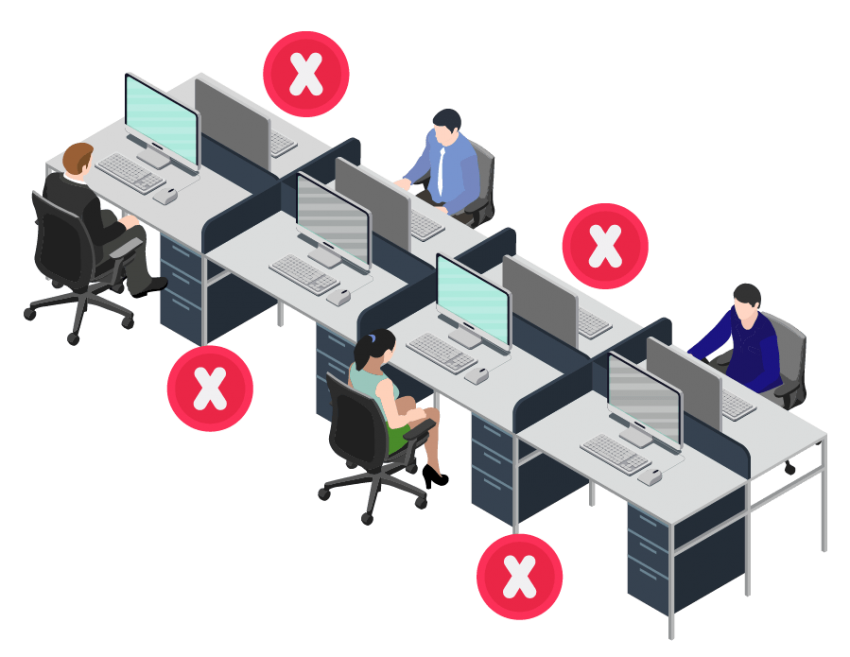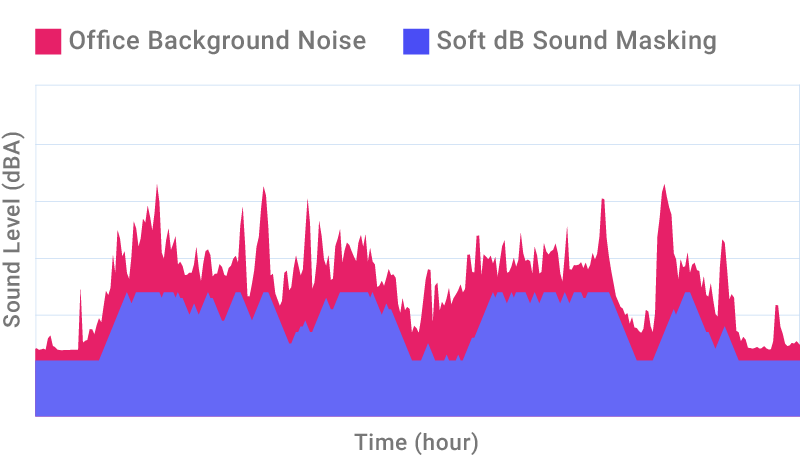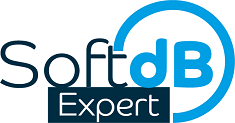Post-COVID Office Spaces
The Future Is Activity-Based Working and Our Sound Masking Technology Is Ahead of the Curve

Every Challenge Is an Opportunity to Become Better, a Better Workspace in Your Case
COVID-19 and the necessary sanitary measures are forcing us to rethink our office spaces. For some companies, the reflection is an entirely new one, a true crash course in getting the usual job done in unusual circumstances. For others, this crisis just provided an opportunity to accelerate their transition to a more flexible work environment – a process already well thought out and well underway prior to the pandemic. After all, virus or no virus, higher workplace flexibility was ranked at the top of most employees’ wishlist for quite some time.
And flexibility they all got, like it or not, as millions of North Americans found themselves working from home, on their own terms, on their own schedule, away from what many began to remember as their old office’s rigid framework. What’s more, many really started to enjoy working remotely from the comfort of their homes. Some even became more productive teammates in doing so. But after months working apart, many also began to miss the office, socializing and collaborating in ways that just aren’t possible remotely. For this reason, spaces that are designed to support these work modes, flexibility and collaboration in particular, aren’t going anywhere.
Nevermind our new responsibility to enforce proper safety measures, inside or outside the office, open-plan designs and activity-based working are here to stay… and grow in popularity. Now more than ever, employees will expect to have the option to choose where in or out of the office they work based on the specific task they have to complete. Welcome to the new normal.
Social Distancing Measures Mean Lower Office Capacity
Whichever way you look at it, your 5000 Sq. feet post-covid office may very well not accommodate the same number of employees as your 5000 Sq. feet pre-covid office. Social distancing will likely turn your 8-person benching workstation into a 4-person benching workstation. If you previously had two people working together in an enclosed office pod, you may now have to rethink that layout altogether.
Depending on current office layout, you may continue to support working from home as a cost-effective strategy to ensure a safer workplace density, or you may view the last couple months as a strong signal that it’s time to redeploy your real estate in completely new ways, fully re-optimizing your office footprint in the process.
Either way, the global COVID-19 pandemic will have had a lasting impact on how you approach just another day at the office. Perhaps even without realizing it just yet, you have already begun your transition toward a model resembling activity-based working.


Lower Office Capacity Calls for Higher Workspace Flexibility
Have you noticed how some of the world’s coolest offices are often located where cost per square foot is most expensive? Scarcity drives creativity and innovation. And when each square foot really matters, improving office space efficiency and boosting employee productivity become one and the same.
Is it really necessary to provide ALL employees with their own assigned desk? What if high-performers preferred to choose a place in the office where it’s most suitable for them to complete certain tasks? That’s what activity-based working is all about: letting employees choose between a variety of work areas, each perfectly designed for a specific activity.
On any given day, the activity-based office design allows them to work in the kind of space that best supports the type of task at hand. No more assigned workstations. No more rigid seating arrangements. Employees are empowered to work on their own terms, in the office just like at home. That’s right, the office may start feeling like home.
More Flexibility Means a Less Predictable Office Soundscape
What about office noise? What about all the distractions, from mundane sounds – such as phones ringing, keyboard typing, coffee grinding and photocopier whirring – to loud conversations among colleagues, just lurking around to steal every worker’s focus across the open floor plan? In an office space with less walls, less boundaries, will employees be able to discuss private, sensitive matters, according to the level of confidentiality required? Will they feel comfortable in doing so?
Both too much and too little noise can be equally detrimental to the office worker experience and performance. And while most reputable sound masking systems out there are designed to perfectly even out your office’s soundscape, doing an especially great job at drowning out private and distracting conversations, how can such systems figure out how loud or quiet the office actually is on any given day, at any minute? How can sound masking be effective in both noisy and quiet conditions?
In the activity-based workplace where two days are never quite alike, managing your sound masking output signal on a predefined schedule just won’t cut it. Your sound masking system will need to be just as flexible as your workspace. It’ll need to dynamically adapt its output to your ever-changing working environment.

How Sound Masking Automatically Adapts to Your Office Soundscape and Makes It Better
Is it a bird? Is it a plane? Is it white noise diffused across the office space or some noise cancelling technology? No. It’s Soft dB’s advanced sound masking system and it emits just the right amount of background sound to cover up the noises and conversations that employees shouldn’t have to hear, at any given time, regardless of how busy or quiet the office gets. No need to pre-schedule it. No need to figure out upfront when or where your office space gets acoustically uncomfortable. Soft dB sound masking automatically ensures greater auditory privacy, confidentiality, and a distraction-free environment, whenever office workers need them most.
When the Office Is Near Full
On a busy day at the post-covid office, things will almost feel back to normal, if it wasn’t for the 1/2 gallon hand sanitizer jugs and the safety signage lying here and there… Employees will be going about their daily workload – answering phone calls, writing emails, hosting live video conferences, finalizing reports, developing brilliant pitches, coding life-saving apps, discussing tough challenges, and exchanging new ideas.
The office will be buzzing with all kinds of activities underway. And of course, the office will be noisy. The more the noisier, right? On such busier, noisier office days, the key challenge brought by activity-based working, and open offices in general, is rather simple:
Making sure that every employee can get in focus and innovate without interruption from an otherwise highly stimulating working environment.
So on such days, the right sound masking system will seamlessly blend in the relatively high office background noise level, while continuously adjusting itself to noisier spikes – typically arising from casual chitchats, loud voices, and verbal communication in general – and quieter lows.
When the Office Is Near Empty
Would you enjoy working in a pin-drop silent room, totally aware of everyone else’s presence, knowing full well that they too can probably hear you breathe, sneeze, cough, stretch, rummage in your drawers for a pen, and even think? Neither does the average office worker.
On a quiet day in the post-covid office, left partially empty by employees having decided to work remotely, those who need to sit in the office that day will find that even the faintest sounds become clearly audible. The ambient noise level will be exceptionally low that’s why. Remember those vast midterm exam rooms in college? It felt slightly uneasy, didn’t it? So when your quiet office gets too quiet, your main challenge is:
Helping office workers feel at ease, silently or not so silently, in their own “private bubble”, oblivious to their surroundings.
On such days, your sound masking system will subtly increase the background noise level just enough to drown out the attention hogging sounds that no employee should be forced to clearly hear, without this little extra background noise becoming a source of distraction in itself.
Activity-Based Workplace Design and Sound Masking Have Worked Hand in Hand for Over 10 Years
For many years, the Kokuyo Group had been a go-to resource for organizations looking to achieve more with less through the activity-based working model. They knew a lot about improving employee performance and well-being by giving them the choice to work however and wherever they see fit. And they certainly had innovative ideas on how future office designs could deliver this most sought-after workplace flexibility.
Activity-Based Working Without Compromise
But Kokuyo also knew full well that activity-based working and open work areas came at a certain cost: tougher acoustics, ever-fluctuating levels of distraction, a lesser sense of privacy, both visual and auditory, and potential confidentiality issues.
Meanwhile, as a world-renowned expert in acoustical engineering with over 20 years of innovations in workspace acoustics, sound measurements and noise mitigation, we at Soft dB knew a lot about solving the acoustical downsides of activity-based working environments.
Indeed, tomorrow’s relationship-driven workplace – with less walls, less boundaries, more space to collaborate, and designed with a premium on flexibility – didn’t have to come at the expense of sonic comfort and privacy. And so began a long and fruitful international partnership between Kokuyo and Soft dB. On one end, a team of experts passionate about taking workspace design to a new level, and, on the other end, a team of experts passionate about achieving superior architectural acoustics.
Privacy and Comfort Without Walls
So for over 10 years now, Kokuyo has been helping companies of all shapes and sizes make the most of activity-based working, while integrating Soft dB’s patented sound masking technology, early in the office design process, to provide employees with:
- Just the right level of auditory privacy and anonymity, without the need for walls
- A place free from noisy distractions for deep focus, creative thinking and getting into flow
- The freedom to take and make phone calls, whatever their nature, without disturbing others
- The ability to openly discuss sensitive matters among colleagues and with superiors, without the fear of being overheard across the entire floor
- The power to be their own comfy self, extroverts and introverts alike – fidgeting around, thinking out loud, snacking on-the-go, sneezing, breathing, dropping a pen – all without becoming the office’s center of attention
And last but not least:
- The right office soundscape, the right level of sonic comfort, that many previously thought to be practically unachievable in open-plan work environments.
